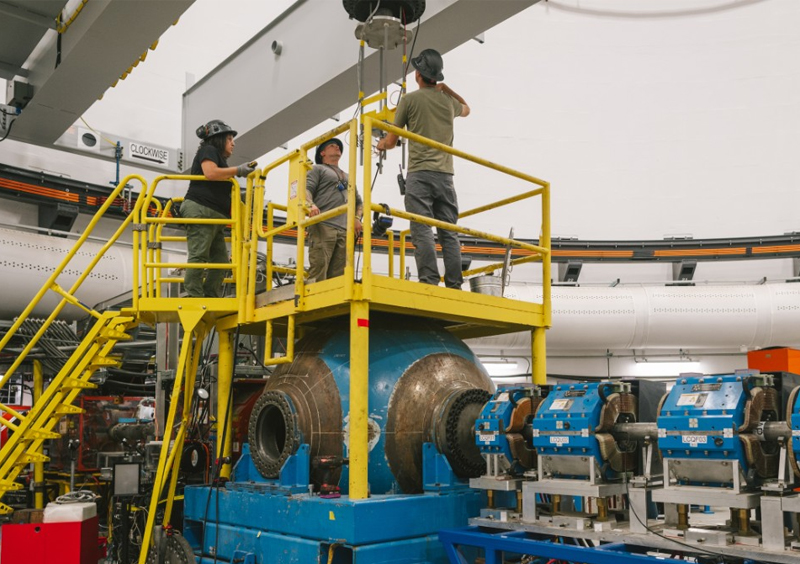At the High-Altitude Water Cherenkov (HAWC) observatory, 13,000 feet above sea level on the Sierra Negra volcano of Mexico, researchers are getting a look into a violent mystery in the Milky Way galaxy. An international research team co-led by Los Alamos National Laboratory observed ultrahigh-energy gamma rays at more than 100 teraelectron volts, tracking their origin to the galactic center for the first time.
“These results are a glimpse at the center of the Milky Way to an order of magnitude higher energies than ever seen before,” said Pat Harding, physicist at Los Alamos and the Department of Energy’s principal investigator for the project. “The research for the first time confirms a PeVatron source of ultrahigh-energy gamma rays at a location in the Milky Way known as the Galactic Center Ridge, meaning the galactic center is home to some of the most extreme physical processes in the universe.”
The HAWC observatory has been gathering data for over seven years. In so doing, the researchers have observed nearly 100 gamma-ray events with energy more than 100 teraelectron volts. As described in analysis led by Sohyoun Yun-Cárcamo in the Astrophysical Journal Letters, that data allows the cosmic ray interactions with the PeVatron to be directly studied and compared with other observations, helping pin down the emission processes and location — right in the center of the Milky Way galaxy.
The most violent processes in the universe
The actual PeVatron itself remains a not-well-understood phenomena, but the fact of its existence in whatever form it takes points to the violent regime in the galactic center. That region of the Milky Way galaxy is known to include a supermassive black hole surrounded by neutron stars and white dwarfs that strip material from nearby stars. The area is shrouded with dense gas clouds that reach temperatures of millions of degrees and tend to prevent much direct optical observation of the region.
The observation of gamma rays thus proves critical for illuminating the cosmic processes at work in that extreme environment. Ultrahigh-energy gamma rays originate with the presence of a PeVatron source, which accelerates particles to a million billion electron volts (PeV) in energy, a quadrillion times more powerful than the light particles coming out of a light bulb. The cosmic-ray protons generated by the PeVatron travel at more than 99% the speed of light, interacting with dense ambient gas and resulting in ultrahigh-energy gamma rays.
The exact nature of the PeVatrons remains a mystery, however. The energies involved point to some of the most violent processes conceivable in the universe: a star’s death in a supernova, the shocks and radiation that accompany the fusion-rich birth of a star, a black hole swallowing up another black hole.
“A lot of those processes are so rare you wouldn’t expect them to be happening in our galaxy, or they occur on scales that don’t correlate with the size of our galaxy,” Harding said. For instance, a black hole eating another black hole would be an event only expected outside our galaxy.”
Cherenkov light in particle detection
HAWC is a unique experiment designed to capture the relatively few ultrahigh-energy gamma rays that can travel interstellar distances and reach Earth. On the slopes of the Sierra Negra volcano, 300 grain silos are filled with water, the bottom of each silo lined with photomultiplier detectors.
When the ultrahigh-energy particles reach Earth’s atmosphere, they break up into extensive air showers of lower-energy particles. As the charged particles pass through the tanks at a speed outpacing the water’s phase velocity, they produce Cherenkov light, or Cherenkov radiation, a blue glow — an effect somewhat similar to the auditory sonic boom. The researchers then analyze the time distribution of the particles detected across tanks to understand the energy regimes at play, deducing the origins of the particles as ultrahigh-energy gamma rays.
Locating the specific PeVatron site
The HAWC observatory experiment has built on the groundbreaking Milagro experiment, a gamma-ray observatory with a 5-million-gallon water pond and 700 light detectors in the Jemez Mountains outside Los Alamos. Milagro took data through 2008, and then researchers moved south to the HAWC observatory to be able to capture particles closer to the galactic center.
The research team plans to extend its HAWC observatory findings and narrow down the specific site of the PeVatron source with a new experiment, the Southern Wide-field Gamma-ray Observatory, a facility being built in the Atacama Desert in Chile. With that wider window into the center of the Milky Way, science may have a closer view of the mystery at the heart of our home galaxy.
Paper: “Observation of the Galactic Center PeVatron beyond 100 TeV with HAWC.” The Astrophysical Journal Letters. DOI 10.3847/2041-8213/ad772e
Funding: The work was supported by the National Science Foundation, the Department of Energy Office of High-Energy Physics, and the Laboratory Directed Research and Development program of Los Alamos National Laboratory.
LA-UR-24-31277






